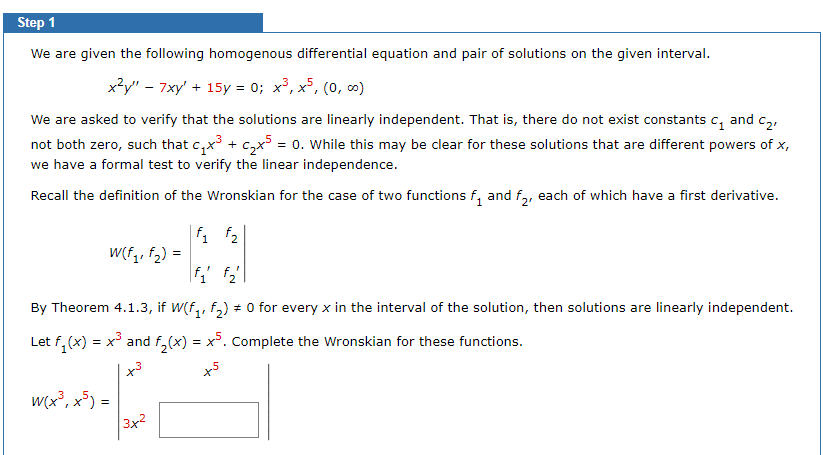Step 1 We are given the following homogenous differential equation and pair of solutions on the given interval. x²y" 7xy' + 15y = 0; x³, x5, (0, ∞) We are asked to verify that the solutions are linearly independent. That is, there do not exist constants c₁ and C₂, not both zero, such that c₁x³ + ₂x³ = 0. While this may be clear for these solutions that are different powers of x, we have a formal test to verify the linear independence. Recall the definition of the Wronskian for the case of two functions f₁ and f2, each of which have a first derivative. f₁ f₂ |f₁ f₂ By Theorem 4.1.3, if W(f₁, f₂) = 0 for every x in the interval of the solution, then solutions are linearly independent. Let f₁(x) = x³ and f₂(x) = x5. Complete the Wronskian for these functions. x5 W(f₁, f₂) = w(x³, x5)= 13x2
Step 1 We are given the following homogenous differential equation and pair of solutions on the given interval. x²y" 7xy' + 15y = 0; x³, x5, (0, ∞) We are asked to verify that the solutions are linearly independent. That is, there do not exist constants c₁ and C₂, not both zero, such that c₁x³ + ₂x³ = 0. While this may be clear for these solutions that are different powers of x, we have a formal test to verify the linear independence. Recall the definition of the Wronskian for the case of two functions f₁ and f2, each of which have a first derivative. f₁ f₂ |f₁ f₂ By Theorem 4.1.3, if W(f₁, f₂) = 0 for every x in the interval of the solution, then solutions are linearly independent. Let f₁(x) = x³ and f₂(x) = x5. Complete the Wronskian for these functions. x5 W(f₁, f₂) = w(x³, x5)= 13x2
Advanced Engineering Mathematics
10th Edition
ISBN:9780470458365
Author:Erwin Kreyszig
Publisher:Erwin Kreyszig
Chapter2: Second-order Linear Odes
Section: Chapter Questions
Problem 1RQ
Related questions
Question

Transcribed Image Text:Step 1
We are given the following homogenous differential equation and pair of solutions on the given interval.
x²y" 7xy' + 15y = 0; x³, x5, (0, ∞)
We are asked to verify that the solutions are linearly independent. That is, there do not exist constants c₁ and C₂,
not both zero, such that c₁x³ + ₂x³ = 0. While this may be clear for these solutions that are different powers of x,
we have a formal test to verify the linear independence.
Recall the definition of the Wronskian for the case of two functions f₁ and f2, each of which have a first derivative.
f₁ f₂
|f₁ f₂
By Theorem 4.1.3, if W(f₁, f₂) = 0 for every x in the interval of the solution, then solutions are linearly independent.
Let f₁(x) = x³ and f₂(x) = x5. Complete the Wronskian for these functions.
x5
W(f₁, f₂) =
w(x³, x5)=
13x2
Expert Solution
This question has been solved!
Explore an expertly crafted, step-by-step solution for a thorough understanding of key concepts.
Step by step
Solved in 2 steps with 2 images

Recommended textbooks for you

Advanced Engineering Mathematics
Advanced Math
ISBN:
9780470458365
Author:
Erwin Kreyszig
Publisher:
Wiley, John & Sons, Incorporated

Numerical Methods for Engineers
Advanced Math
ISBN:
9780073397924
Author:
Steven C. Chapra Dr., Raymond P. Canale
Publisher:
McGraw-Hill Education

Introductory Mathematics for Engineering Applicat…
Advanced Math
ISBN:
9781118141809
Author:
Nathan Klingbeil
Publisher:
WILEY

Advanced Engineering Mathematics
Advanced Math
ISBN:
9780470458365
Author:
Erwin Kreyszig
Publisher:
Wiley, John & Sons, Incorporated

Numerical Methods for Engineers
Advanced Math
ISBN:
9780073397924
Author:
Steven C. Chapra Dr., Raymond P. Canale
Publisher:
McGraw-Hill Education

Introductory Mathematics for Engineering Applicat…
Advanced Math
ISBN:
9781118141809
Author:
Nathan Klingbeil
Publisher:
WILEY

Mathematics For Machine Technology
Advanced Math
ISBN:
9781337798310
Author:
Peterson, John.
Publisher:
Cengage Learning,

